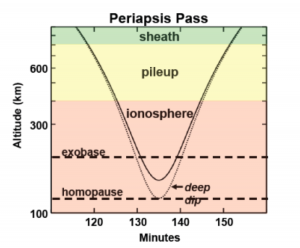Bruce Jakosky, MAVEN principal investigator at CU-Boulder’s Laboratory for Atmospheric and Space Physics

MAVEN is about to carry out its first “deep-dip” campaign. This involves lowering the lowest altitude in the orbit from about 150 km above the surface to about 125 km. We do this so that we can measure the properties of that additional 25 km of the upper atmosphere between 150 and 125 km. It doesn’t seem like much, but this lets us go all the way down to the top of what we call the lower atmosphere, and it will let us make the connection then from the top of the upper atmosphere all the way down to the surface.
We’ll use three rocket-motor burns to lower the orbit, spread over three days. We do it gradually so that the spacecraft can “walk in” and we don’t get taken by surprise by anything along the way. Then we’ll stay in the “deep dip” orbit for five days, which covers about 20 orbits around the planet. Finally, we’ll use two maneuvers to “walk” back out and get back to our regular science mapping orbit.
We carried out the first of the “walk in” maneuvers successfully during the evening of February 10th. It lowered the spacecraft periapsis from ~155 km to ~134 km, and is the largest of the three maneuvers. The second maneuver will be carried out on February 11th. It’s going to be an exciting week!
We don’t stay in this deep dip orbit all the time because the atmospheric density at these altitudes, as tenuous as it is, is too large. The drag on the spacecraft would cause us to spiral into the planet, and the gas could affect our electronics. As a result, we’re planning to carry out these campaigns five times during the one-year mission.
As of today, MAVEN is almost three months into its science mapping mission. We’re still learning how to use the instruments and the data. The mission is going smoothly, and the data are spectacular! We’re planning to try to put it together into a coherent picture of the upper atmosphere in order to present it at the Lunar and Planetary Science Conference in mid-March. That will be the first time that we have real “preliminary science results from the MAVEN mission”!

